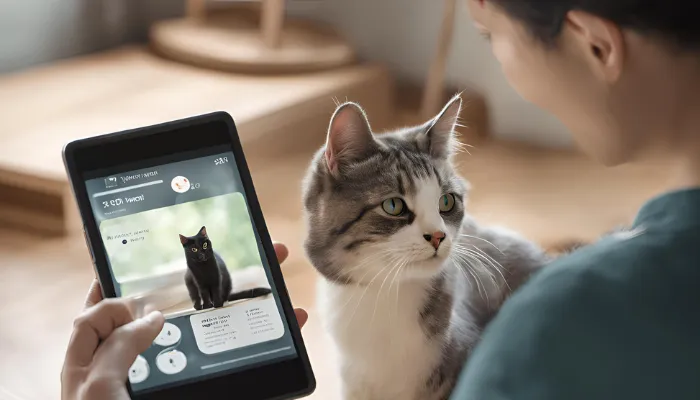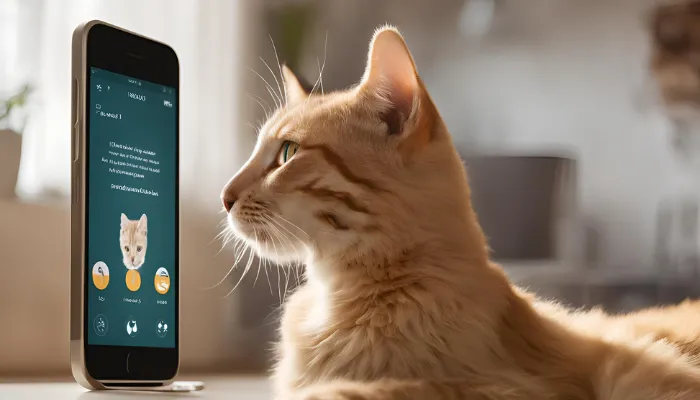Have you ever thought if there is an actual cat translator or English to cat translator? As passionate cat enthusiasts, we try to interpret the strange meows, purrs, and chirps made by our cats. Even if we think we can recognize their moods from their sounds or actions, actual understanding of communication seems far ahead.
Many pet owners are intrigued by whether technology can really bridge the gap between human speech and cat sound with English to cat language translator online tools and apps. In this article, we will look into the science, the myths, and the technology behind these interesting tools to see if they can really help us communicate with our cats.

English to Cat Translator: What is it?
An English to cat translator is a device or app designed to “translate” human words into sounds that mimic feline vocalizations. These tools claim to help humans communicate with their cats by converting phrases into meows, purrs, and other cat-like noises.
How Do They Work?
Most English to cat translators function by:
- Recording Your Voice: You speak a phrase into the app or device.
- Analyzing the Words: The tool processes your words and assigns them to pre-recorded cat sounds.
- Generating Cat Sounds: It plays back meows or purrs that correspond to the emotions or intents of your phrase.
While not scientifically proven to translate perfectly, English to cat translators offer a fun and engaging way to interact with your feline friend.

Do Cats Understand These Translations?
Have you ever questioned whether cats comprehend those playful meows from English to cat translator applications? Let’s explore how cats communicate and whether technology truly bridges the gap.
Science of Cat Communication:
Cats communicate through a mix of vocalizations, body language, and scent. While humans rely heavily on spoken language, cats are more attuned to:
- Tone of Voice: Cats can detect changes in pitch and emotion.
- Body Language: Tail movements, ear positions, and eye contact are key.
- Contextual Cues: Cats associate sounds with experiences rather than words.
Can Technology Mimic This?
While English to cat translators can replicate meows, they often miss the nuances of real feline communication. For example:
- A meow from the translator might sound accurate but lack the correct emotional tone.
- Cats might respond out of curiosity rather than understanding.
These cat language translator apps can certainly be amusing, but they miss out on the nuances that real feline speech entails, so use them for fun, but do not expect your cat to start conversing with you!
Popular English to Cat Language Translators Online
There are several English to cat language translator online tools available. Let’s take a look at some of the most popular ones:
| Translator Name | Features | User Reviews |
|---|---|---|
| MeowTalk | Records and translates human speech | Mixed responses |
| Human-to-Cat Translator | Offers a variety of meow sounds | Fun but not accurate |
| Cat Translator App | Simple interface with playful sounds | Entertaining |
MeowTalk
Developed by a former Amazon engineer, MeowTalk attempts to decode your cat’s meows and translate them into English. It also allows you to “talk” back to your cat with cat-like sounds.
Human-to-Cat Translator
This app claims to convert your voice into realistic meows. While it may not truly communicate with your cat, a human to cat translator can be a fun way to engage with your pet.
Cat Translator App
A playful app designed to entertain rather than scientifically communicate. It offers a range of cat sounds for different moods.
These English to cat translator tools might not guarantee purr-fect communication, but they’re sure to add a little extra fun to your interactions with your furry friend!

How to Use an English to Cat Language Translator Online?
Now, using an English to cat language translator online will help you interact with your cat. If you want to know how to do it step by step, here it is:
- Choose a Reliable Translator: You will need to find an application or a website that has a good reputation and is user-friendly.
- Record Your Message: You can now Speek or type phrases in English such as “I love you” or “time to eat.”
- Play the Translation: The translator will convert what has been recorded into cat-like sounds i.e., meows and purrs.
- Observe Your Cat’s Reactions: Just pay attention to the reaction of your cat. Some will indeed be inquisitive while other cats may just not bother with it.
- Use Sparingly: Cats depend on tone and body language, so make sure not to overdo it while using these aids to communicate, because they should only be used to augment your communication with your cat.
While these translators are a fun way to bond with your pet, nothing can replace real communication with your kitty!
Best Practices When Using a Cat Translator
To get the most out of your English to cat translator, it’s important to use it thoughtfully and in the right environment.
- Choose a Quiet Space:
Background noise can interfere with both the recording and playback of sounds. Use the translator in a calm, quiet area where your cat feels comfortable. - Observe Your Cat’s Reactions:
Pay close attention to how your cat responds. Some may be curious or playful, while others might be confused or indifferent. Understanding their reactions helps you adjust your approach. - Keep Sessions Short:
Cats have short attention spans, so keep interactions brief to prevent overstimulation or frustration. - Make Sure Your Cat Is in the Right Mood:
Try using the translator when your cat is relaxed and receptive—after a nap or during quiet time—not when they’re agitated or overly active. - Combine with Body Language:
Cats rely heavily on non-verbal cues. Pair the translated sounds with gentle gestures, like slow blinking or offering a treat, to reinforce positive communication. - Don’t Overuse the Tool:
Frequent use may cause your cat to lose interest. Use the translator occasionally to keep interactions fresh and engaging.
If you heed these tips, you will strengthen the bonds that you have with our furry friend and get the maximum usage from your cat translator.
Pros and Cons of Using an English to Cat Translator
Using an English to cat translator can be a fun way to engage with your feline friend, but like any tool, it has its advantages and limitations.
Pros:
- Enhanced Bonding: You can encourage interaction between you and your cat which, in turn, will strengthen the bond between the two of you.
- Entertainment Value: Watching your cat respond to the translated phrases is entertaining on multiple levels.
- Insight into Behavior: Some of them provide analyses that may give you clues into your cat’s needs and how it’s feeling.
Cons:
- Accuracy Limitations: A cat’s various vocalizations and body movements are far too complex for translation to be done accurately.
- Over-Reliance on Technology: Using these tools too much can draw focus away from understanding the different cues that your cat offers naturally.
- Potential Confusion: Some cats can be prone to frustration due to getting confused from artificial or incorrectly translated sounds.
As with any field of pet care, an English to cat translator can provide a unique but playful perspective, but it is best used in conjunction with actual interaction and observation.
Tips to Communicate Better with Your Cat
Even though cat translator app can be amusing, there are better ways to interact with your feline friend that will improve your flow of communication.
- Observe Body Language: Cats express a great deal with their body movements, tail, and even ears. Understanding these signals can help you notice and appreciate comfort, stress, or even aggression.
- Use Vocal Cues: Cats can sense tone changes. When trying to soothe them, speak soothingly. However, when trying to give commands, speak firmly.
- Establish Routines: Cats find comfort in patterns. Regular intervals for meals, play activities, and grooming will greatly enhance their sense of security.
- Positive Reinforcement: Certain actions performed by your cat can be encouraged through pets, sweets, or by game playing in order to reinforce those actions to be done again.
- Respect Their Space: Allowing your cat to dictate when to approach and allowing it will over a period of time assist in growing trust.
Identifying and understanding behavioral signals from a cat such as those mentioned above eliminates the need for a cat translator as you will be able to bond more deeply with your feline friend.
Conclusion
In conclusion, while an English to cat translator can bring laughter and amusement while listening to your pet cat, it does not ensure accurate results. Such applications and devices may attempt to produce cat sounds, but they do not capture the real essence of cats which is dependent on a mix of non-verbal cues, voice modulation, and context of the situation.
Looking through an English to Cat language translator online can lead to speculation and play, but the primary method of seeing how deeply your cat wants to be understood is through studying their actions, sounds, and feelings. So, while these tools can liven up and enable greater fun when dealing with your pet, your most sincere interactions stem from love, mindfulness, patience, and care.
By marrying technology and instinctive concern with careful watching, you will form a meaningful relationship with your pet.
